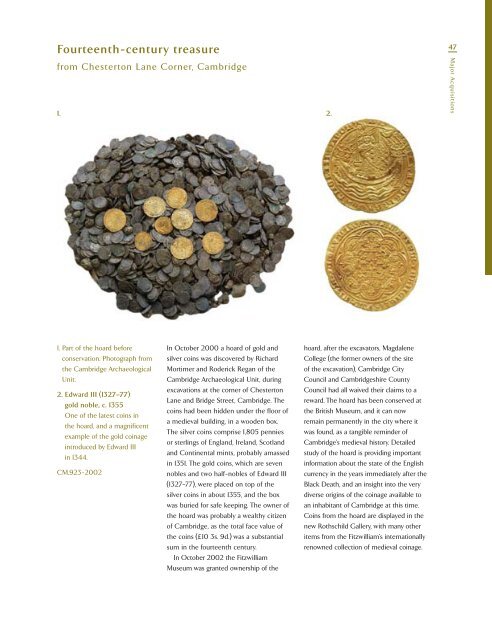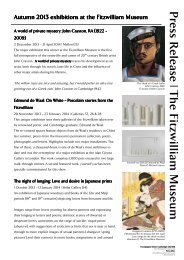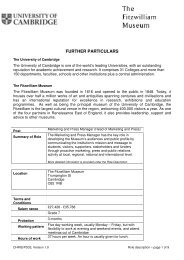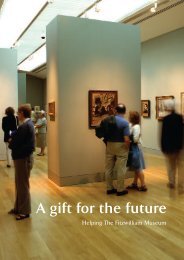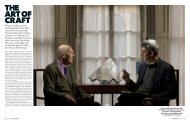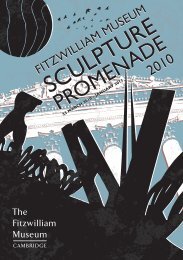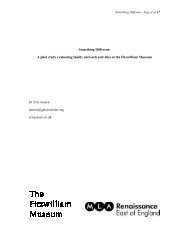The Fitzwilliam Museum - University of Cambridge
The Fitzwilliam Museum - University of Cambridge
The Fitzwilliam Museum - University of Cambridge
You also want an ePaper? Increase the reach of your titles
YUMPU automatically turns print PDFs into web optimized ePapers that Google loves.
Fourteenth-century treasure<br />
from Chesterton Lane Corner, <strong>Cambridge</strong><br />
1.<br />
1. Part <strong>of</strong> the hoard before<br />
conservation. Photograph from<br />
the <strong>Cambridge</strong> Archaeological<br />
Unit.<br />
2. Edward III (1327–77)<br />
gold noble, c. 1355<br />
One <strong>of</strong> the latest coins in<br />
the hoard, and a magnificent<br />
example <strong>of</strong> the gold coinage<br />
introduced by Edward III<br />
in 1344.<br />
CM.923-2002<br />
In October 2000 a hoard <strong>of</strong> gold and<br />
silver coins was discovered by Richard<br />
Mortimer and Roderick Regan <strong>of</strong> the<br />
<strong>Cambridge</strong> Archaeological Unit, during<br />
excavations at the corner <strong>of</strong> Chesterton<br />
Lane and Bridge Street, <strong>Cambridge</strong>. <strong>The</strong><br />
coins had been hidden under the floor <strong>of</strong><br />
a medieval building, in a wooden box.<br />
<strong>The</strong> silver coins comprise 1,805 pennies<br />
or sterlings <strong>of</strong> England, Ireland, Scotland<br />
and Continental mints, probably amassed<br />
in 1351. <strong>The</strong> gold coins, which are seven<br />
nobles and two half-nobles <strong>of</strong> Edward III<br />
(1327–77), were placed on top <strong>of</strong> the<br />
silver coins in about 1355, and the box<br />
was buried for safe keeping. <strong>The</strong> owner <strong>of</strong><br />
the hoard was probably a wealthy citizen<br />
<strong>of</strong> <strong>Cambridge</strong>, as the total face value <strong>of</strong><br />
the coins (£10 3s. 9d.) was a substantial<br />
sum in the fourteenth century.<br />
In October 2002 the <strong>Fitzwilliam</strong><br />
<strong>Museum</strong> was granted ownership <strong>of</strong> the<br />
2.<br />
hoard, after the excavators, Magdalene<br />
College (the former owners <strong>of</strong> the site<br />
<strong>of</strong> the excavation), <strong>Cambridge</strong> City<br />
Council and <strong>Cambridge</strong>shire County<br />
Council had all waived their claims to a<br />
reward. <strong>The</strong> hoard has been conserved at<br />
the British <strong>Museum</strong>, and it can now<br />
remain permanently in the city where it<br />
was found, as a tangible reminder <strong>of</strong><br />
<strong>Cambridge</strong>'s medieval history. Detailed<br />
study <strong>of</strong> the hoard is providing important<br />
information about the state <strong>of</strong> the English<br />
currency in the years immediately after the<br />
Black Death, and an insight into the very<br />
diverse origins <strong>of</strong> the coinage available to<br />
an inhabitant <strong>of</strong> <strong>Cambridge</strong> at this time.<br />
Coins from the hoard are displayed in the<br />
new Rothschild Gallery, with many other<br />
items from the <strong>Fitzwilliam</strong>'s internationally<br />
renowned collection <strong>of</strong> medieval coinage.<br />
47<br />
Major Acquisitions


